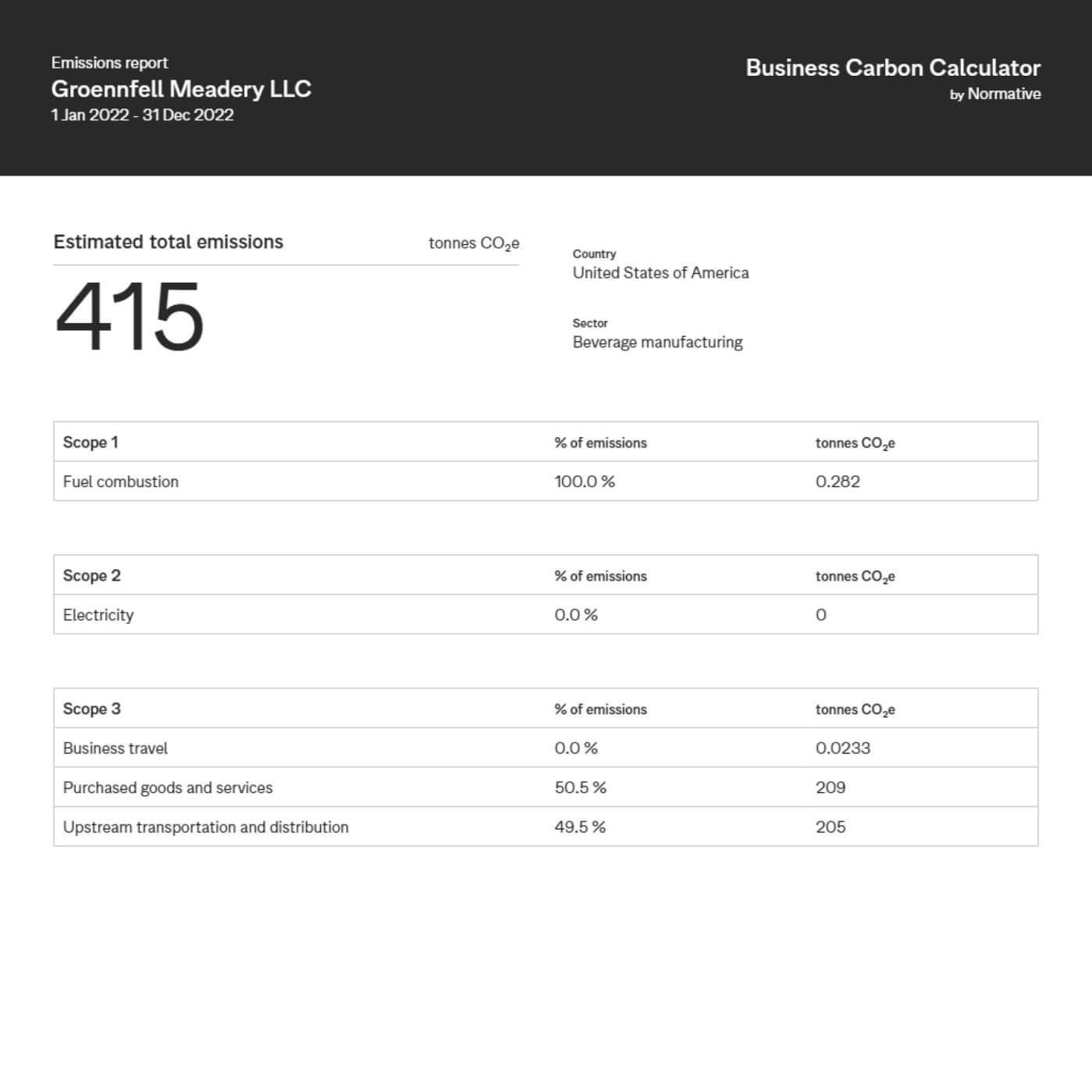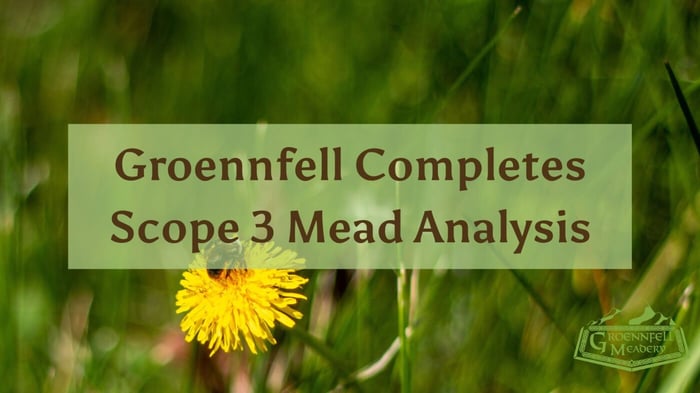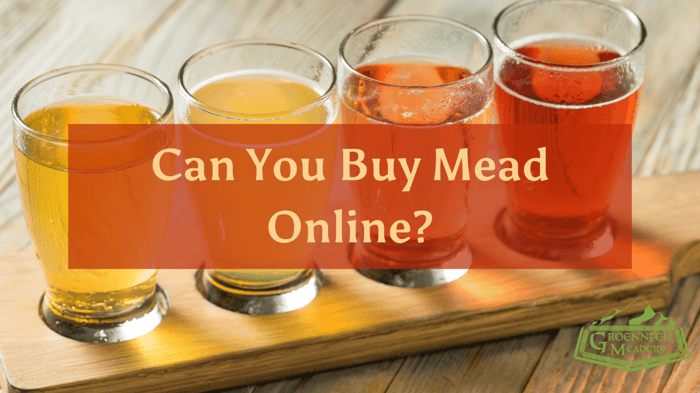This month, Groennfell Meadery completed a full Scope 3 mead analysis for all of our production and brewing facilities. So, how did we do?
Short answer: Really, really well.
What is a Scope 3 Analysis?
A Scope 3 Analysis is an attempt to capture all of the data around a company's CO2 and CO2 equivalent (CO2e) emissions. Without this data, it's impossible to know how we're doing on our Net-Zero goal and where we have the biggest opportunities to make improvements.
By definition, a Scope 3 Mead Analysis would include the data from Scope 1 and Scope 2 and give us a picture of the environmental impact of each can and bottle we sell.
Going through all three types of emissions will make it easier to understand.

What's included in a Scope 1 Analysis?
A Scope 1 Analysis covers direct emissions from our production. For example, we use renewable natural gas to heat our cleaning water. Burning that fuel creates CO2. Since we are using renewable natural gas, it's a bit more complicated... well, a lot more complicated, but it's a big part of our strategy to maintain NetZero emissions. You can learn about that and our other initiatives here.
Additionally, if we used a non-compliant refrigerant and it leaked (HFCs for example,) this would be a Scope 1 emission, and, frighteningly, many companies with large refrigeration have no idea that this is their primary contribution to climate change. HFCs are over 3,500 times more damaging than CO2.
Company vehicles are also included in this section of the report. Staff commutes are usually included in Scope 2, but it can get a little tricky, especially if you have a sales team.
That said, Scope 1 is also where our woodlands come into play. We maintain seven acres of riparian habitat as well as a one-acre regenerative farm, which both act as carbon sinks.
Since honey is produced from existing CO2 in the atmosphere, ultimately via photosynthesis, the CO2 released during fermentation is automatically Net-Zero. The fact that we recapture that CO2 for growing plants makes it ever so slightly net negative. Our mushrooms, by the same token, are also Net-Zero because they grow on a substrate from nature (wood chips and cardboard, in our case) and respire CO2.

What's included in a Scope 2 Analysis?
Scope 2 is the easiest part of the analysis since it's only your purchased power. We are 100% powered by the sun (and a tiny, tiny percentage by renewable natural gas), so we got the best score you can get in this category: 0.
For folks that buy in their power, it gets a little more complicated because you need your power company to give a source breakdown for you. Most power companies are now able (or even required) to do this, so it just takes a little bit of emailing.
What's included in a Scope 3 Analysis?
This is where things get very challenging and why it took us so long to complete our Scope 3 Mead Analysis.
Scope 3 includes all of the indirect emissions from your company through your whole supply chain. The honey we buy, the trucking companies we use to ship mead, the box manufacturers, whether our customers actually recycle their cans or not... this is all included in Scope 3.
As you can imagine, we had to use a lot of EPA-accepted estimates for this section, for example, the percentage of consumers who recycle their packaging as well as the energy required to recycle aluminum versus making new cans.
Not all honey is created equally. Is our honey a byproduct of another ag business? Is it wildflower? How far did it travel? What was the energy source used to process the honey? We have some of this information thanks to our amazing partners, but we also relied heavily on a study by UC Davis. It definitely doesn't account for our 100% recyclable totes!

Interestingly, business travel is usually included in this section. The fact that we never go anywhere (thank you, COVID) really helped us there.
As you can imagine, the vast majority of our emissions come from this category. Specifically 99.94% of our emissions.
Most of these numbers were derived from the amount we paid for the different products. Rapid inflation has skewed this data fairly substantially, but it still paints a very clear picture.
So what's our final score?
Well, it's not really a score. It's more of a number.
All of our production produces 415 Tons of CO2 per year.
Between our farm and the woods, we're recapturing about 8 tons of CO2 every year based on a recent Vermont Forestry Analysis.
This gives us a net "score" of 407 Tons of CO2 per year.
Now, let's give that number some context.
According to Nature.org, the average American has a 16-ton CO2e footprint. You can calculate yours with this amazing tool here. That means our meadery produces as much CO2e as about 25 Americans. (Or 100 humans from the rest of the world.)
Last year we canned about a quarter million cans of mead (thanks to COVID, we did almost no kegs). According to our report, it was 269,920, so we'll go with that number.
That works out to 663 grams of CO2e per pint of mead.
How does mead's CO2e compare to other beverages?
(Or, is mead better for the environment than beer and wine?)
That is a shockingly hard question to answer. Only one major brewery has undertaken a certified Scope 3 Analysis, and that's New Belgium Brewing. The report is about 15 years old, but it works out to 708 grams of CO2e per pint of beer.
New Belgium Brewing is a very environmentally-focused company, so it's safe to assume this number is on the low side for beer production.
While there are many sites that give you the CO2e for different foods, drinks, and activities, these are almost always Scope 2. For example, the energy to extract lithium for an electric car isn't included when they give the CO2e per mile of driving, only the Scope 2 which is the CO2e of the electricity from the grid.
You can personally dramatically change the CO2e for your mead or beer, for example, by choosing not to have a designated beverage fridge. That can have a higher impact than all of the processing and transportation put together.
Additionally, comparing beverages is tricky because modern conventional ag with heavy tillage is one of the leading sources of CO2e emissions worldwide, but regeneratively grown crops can sink more carbon per acre per year than almost any forest.
For now, we're going to leave it with this: You can't beat the Scope 3 for drinking a pint of water. If you want to drink alcohol and reduce your footprint, mead, wine, and locally-produced cider are probably your best options.
What is Groennfell Meadery doing to reduce our CO2 footprint?
We're doing a lot!
In addition to fun little projects like experimenting with upcycling packaging, we've also transitioned to seasonal and domestic fruit so that we can dramatically reduce the energy needed to chill and transport the fruit.
Transportation of ingredients to our meadery and shipping mead to all of our fans is the number one area where we can improve.
Right now, the jury is out about whether having products shipped to your home or getting them at the store is better for the environment. There are so many vested interests in promoting one over the other that it's essentially impossible to get a clear picture at this time.
What we do know is that it takes a lot more packaging (and staff time) to get mead shipped to a home compared to simply loading a pallet onto a trailer. Finding more environmentally friendly packaging and encouraging people to recycle (or, better yet, upcycle) their packaging is a key step.
Finding partners who also use 100% renewable energy for their production will help as well.
We really want an electric company car, of course, but that's not in the budget.
Kegs are also (generally speaking) more environmentally friendly than cans, so holding more local events with pints of mead is something we're really excited to pursue.
And more... over the coming months we'll continue to document all of the progress we make, as well as the setbacks.
Is drinking mead good for the environment?
In the end, as we said above, it's really tough to beat the environmental footprint of a glass of water. But if you're going to drink alcohol, it's important to know where your beverage comes from.
We are proud to use 100% raw wildflower honey shipped in 100% recyclable totes. We get our drums of fruit shipped dry (meaning no refrigeration) so that we can reduce our energy use throughout that whole supply chain. That means that we have to have the logistics in place to brew with the ingredient the day of its arrival.
There's so much more that we can do together. We can advocate for better agricultural practices which would help reduce the footprint of all alcoholic beverages. We can buy locally whenever possible. We can promote improved rail infrastructure to reduce the CO2 associated with shipping ingredients.
Together, we can get a pint of mead to Net-Zero emissions, but it's going to take all of us working together to change the very nature of US shipping and production.




